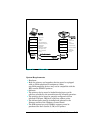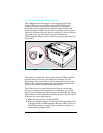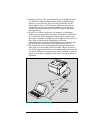
Infrared Communication
The HP LaserJet 5, 5M, and 5N printers are equipped with an
Infrared Datalink Association (IrDA) compliant port. The IrDA
specification allows “wireless” transmission of print data between
a wide variety of hosts (primary) and peripheral (secondary)
devices. A primary device — such as a PC or laptop computer —
is capable of reading and writing data to another primary device
or writing to a secondary device, such as a printer. Secondary
devices are read-only; they cannot initiate their own
communication, and can only respond to a host command when
properly addressed.
The IrDA protocol uses a transceiver chip in both devices to send
and receive data packets. The packets are checked for validity,
and a response is sent by the secondary device indicating whether
the packets were complete or in error.
The IrDA protocol is contained in three layers:
• The physical electronics are the hardware elements in each
device for sending and receiving the data.
• The Link Access Protocol (LAP) layer controls the physical
layer, packetizes/unpacketizes data, and sets transmission
rates.
• The Link Management Protocol (LMP) layer routes data to
and from the host operating system (DOS/Windows).
The data flow is shown in Figure B-5.
The LAP and LMP layers can reside in either firmware, software,
or a combination of both. There are different LAP and LMP
protocols for primary and secondary devices.
The HP LaserJet 5 printer has the complete secondary protocol,
and any host trying to communicate via the infrared (IR) port
must have the complete primary protocol installed. The primary
protocol software is the responsibility of the host supplier. It is
not provided by Hewlett-Packard with the printer.
IrDA host (or primary device) communications can be obtained
either via an internal IR port or an external IR accessory. Several
manufacturers offer complete accessory upgrades for both host
and peripheral devices.
B-34 LaserJet 5/5M/5N Printer


















